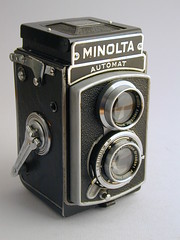Minoltaflex Automat
See also the 1937 Minoltaflex (I), the later Minoltaflex Automat prototypes and the postwar Minoltaflex II and III.
The Minoltaflex Automat (ミノルタフレックスオートマット) is a 6×6cm TLR (twin lens reflex) camera for 120 film made from 1941 by Chiyoda Kōgaku Seikō (predecessor of Minolta).
Contents
Description
The Minoltaflex Automat is an evolution of the earlier Minoltaflex, from which it retains the same body casting, viewfinder and front standard. Unlike the previous model, the camera has an advance crank on the photographer's right, winding the film and cocking the shutter in the same movement. It automatically stops for each exposure, and it is unlocked by tripping the release button. The frame number is displayed in a small round window on the same side.
The L-shaped back is identical to that of the Minoltaflex. It is hinged at the top and retained by a latch at the bottom; the serial number is inscribed inside and there is an exposure table attached behind — the latter is written in English, something rather surprising for a Japanese camera of the era. The two film flanges placed on the photographer's left are pulled out for film loading, and the position of the first exposure is set via a red window, placed under the camera and protected by a sliding cover. After that, the exposure counter mechanism is engaged by a small button at the top of the right-hand side plate.
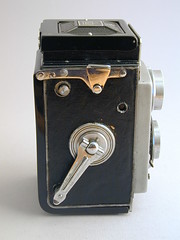 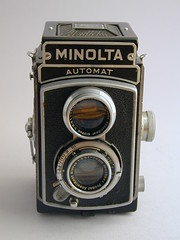  
|

|

| |
| Minoltaflex Automat no.17572, Crown II shutter (B, 1–300), Promar Anastigmat Nippon 75mm f/3.5 taking lens no.105561, Minolta Anastigmat Nippon 75mm f/3.2 viewing lens no.21586. Pictures by eBayer hbpartner. (Image rights) | |
The front plate is moved back and forth for focusing, and has a silver finish on all sides, replacing the black finish of the original Minoltaflex. Compared with the previous model, the camera also has newer strap attachments on both sides, and the focus knob has been moved to the photographer's left to leave space for the advance crank. The knob itself has an unchanged chrome finish with a black top, and runs along a black depth-of-field scale showing indications for 3.5, 8 and 16 apertures.
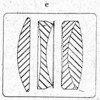
|

|
| Scheme and description of the Promar lens. (Image rights) |
The viewfinder provides automatic parallax correction via a mask on the ground glass screen, which moves back and forth when the focus knob is turned, the same as on the previous Minoltaflex.[1] The four-fold viewing hood, inspired by that of the Ikoflex II, is the same too. Its middle part has the shape of a truncated pyramid and a TIYOKO logo in the middle; it can be pushed back, releasing a built-in magnifying lens then revealing a sports finder. The words MINOLTA and AUTOMAT appear on the nameplate, placed in front of the viewfinder.
The Minoltaflex Automat has the same lenses as the regular Minoltaflex. The taking lens is a four-element Promar 75mm f/3.5, made by Asahi Kōgaku (predecessor of Pentax);[2] the marking on the rim is Promar Anastigmat Nippon or Promar Nippon. The viewing lens is a 75mm f/3.2, marked Minolta Anastigmat Nippon or Minolta Nippon, reportedly made by the Chiyoda company itself, perhaps in the Sakai plant.[3] Both lenses have a silver rim, thicker than on the Minoltaflex, and take 31.5mm diameter push-on accessories.[4]
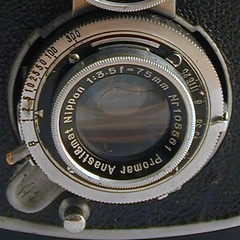 
|
| Left: Promar Anastigmat Nippon 75mm f/3.5 taking lens no.105561 in Crown II shutter (B, 1–300). The shutter's nameplate is missing. Right: Minolta Anastigmat Nippon 75mm f/3.2 viewing lens no.21586. Pictures by eBayer hbpartner. (Image rights) |
The shutter is a Crown II (B, 1–300) made by Chiyoda itself. The name CROWNⅡ–TIYOKO is inscribed on a small crescent-shaped nameplate screwed to the shutter plate, on the left of the lens (as seen from the front); the aperture scale is on the other side. The release lever mounted on the first examples was soon subsituted by a button is placed on the front plate, under the shutter unit (see the variations below). It is interlocked with the advance mechanism to provide double exposure prevention.
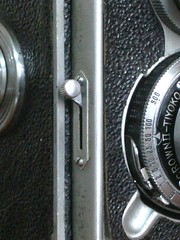
|
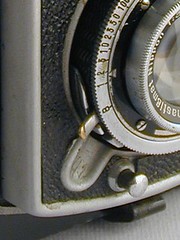
|
| Early release lever. Picture by eBayer Yalluflex. (Image rights) |
Regular release button. Picture by eBayer hbpartner. (Image rights) |
The dimensions are 98×100×138mm, and the weight is 1,000g.[5]
Commercial life
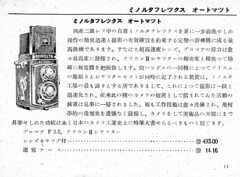
|
| Minoltaflex Automat in the October 1941 catalogue by Asanuma Shōkai. (Image rights) |
Many sources say that the Minoltaflex Automat was released in 1939; this date appears in the chronology published by the company in September 1958 in Shashin Kōgyō, in Minolta's fifty-year chronicle and is repeated elsewhere.[6] However the camera does not appear in the official list of set prices compiled in October 1940 and published in January 1941, which gives a supposedly exhaustive list of all the Japanese camera production.[7]
The earliest appearance of the camera known so far is in the October 1941 catalogue by Asanuma Shōkai, where the camera is listed for ¥493 — this price includes the lens cap but not the ever-ready case, sold separately for ¥14.16. The camera was advertised in Japanese photographic magazines from January 1942.[8] It seems that the price remained unchanged at least until January 1943.[9] At the time, the Minoltaflex Automat was the most expensive of all Japanese cameras, except the Canon.[10]
The Minoltaflex Automat is mentioned in the April 1943 government inquiry on Japanese camera production,[11] and the last reported advertisement is dated August 1943;[12] the production was probably stopped around that time.
It seems that one of the TLR models made by the Chiyoda company was supplied to the military and received an official inventory name. Awano suggests that this was the Minoltaflex Automat,[13] but an interview of Tashima Gizō mentions the "Flex", probably meaning the original Minoltaflex.[14]
Variations
  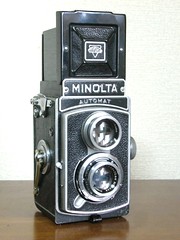 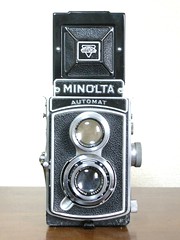
|
  
|
| Minoltaflex Automat, early version, Crown II shutter (B, 1–300), Promar Anastigmat Nippon 75mm f/3.5 taking lens no.96698, Minolta Anastigmat Nippon 75mm f/3.2 viewing lens no.15250. Pictures by eBayer Yalluflex. (Image rights) |
The early examples have the release lever on the side of the front plate, as on the original Minoltaflex, and have thick lens rims.[15] Examples are known with body number in the 11xxx range and taking lens number in the 96xxx and 97xxx range. (The lowest body number observed so far on a Minoltaflex Automat is no.11406.)

|
| Serial number inside the back. (Image rights) |
The regular examples have a release button on the front plate, below the shutter housing, and have thinner lens rims. Surviving examples are known with body numbers from 14587 to 23846, taking lens numbers from 100151 to 112188 and viewing lens numbers from 17334 to 29465. The engraving on the lens rims lost the word Anastigmat around taking lens no.106000 and viewing lens no.23000. The late examples with body number above c.20000 have no exposure table on the back (as for the original Minoltaflex).
One camera with interesting features was shown by Mieno Tsuguharu in a letter to Camera Collectors' News.[16] It has taking lens no.112188 and viewing lens no.29465, the last observed on an Automat. These were mounted on a slightly earlier body, with serial no.18828 and an exposure table on the back. Removal of the MINOLTA AUTOMAT nameplate reveals the abbreviated company name Chiyokō in kanji characters 千代光, and No26199. Similar engravings (with No2602) are found on the "type A" interchangeable-lens prototype, which was probably made c.1943 for the military.[17] The Automat pictured in the letter also has a PC synch socket at the front, at the exact same place as the synch connector of the "type A" camera. Though no textual evidence has remained of this, it looks like this particular Automat was part of a very late batch with added flash synchronization, perhaps made on behalf of the military. The extra serial number 26199 might be a military number in a sequence starting at 2600 or 2601, perhaps an allusion to year 2600 in the old Japanese calendar used during the military period, corresponding to 1940 CE.
Total production and current condition
The Minoltaflex Automat was made in the same Amagasaki (尼崎) plant which produced the Minoltaflex and the Minolta bakelite models.[18]
It is difficult to give a precise estimate of the total production, because the numbering sequence was common to the Minoltaflex. From the known serial numbers, it seems certain that less than 25,000 were made of the two models; for the Minoltaflex Automat alone, we can attempt a rough estimate of 5,000 to 10,000 units.
It is said that the film advance mechanism of the Minoltaflex Automat was not very reliable, because the materials used during the troubled production period were inadequate.[19] Various surviving cameras indeed show traces of repair and tinkering with the advance mechanism. For example, at least one very late camera was modified by removing the auto-stop mechanism and exposure counter, and moving the red window to the middle of the back, for manual control of the film advance.[20]
Accessories
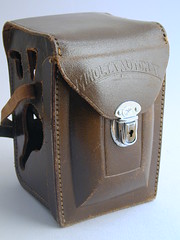
|
| Ever-ready case. Picture by eBayer hbpartner. (Image rights) |
The original ever-ready case is made of brown leather, and has the name MINOLTA AUTOMAT embossed at the front, above the latch. The double lens cap is black with the TIYOKO logo at the top and the name Minolta Flex at the bottom.
 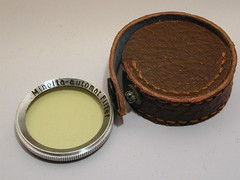
|
| Left: close-up lens set P.X–No.1. Right: yellow filter. Pictures by eBayer hbpartner. (Image rights) |
The filter pictured above was certainly offered by Asanuma Shōkai as a dedicated accessory; it has a silver rim, engraved Minolta–automat Filter, and comes in a small case embossed Minoltaflex.
The close-up lens set is exactly similar to the set sold for the original Minoltaflex, but for the larger 31.5mm diameter. It was copied on the Proxar and Rolleipar set of the Rolleiflex, and consists of two identical lenses, inscribed 31.5 and P.X–No.1 or P.X–No.2, and one parallax correction device for the viewing lens, inscribed Minolta Flex Auto Mat and Ro–P.X–No.1 or Ro–P.X–No.2. The three elements are contained in a small case with a Minoltaflex embossing.
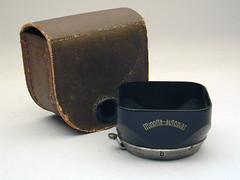  
|
| Left and middle: square hood. Right: round hood with filter holder. Pictures by eBayer hbpartner. (Image rights) |
At least two types of hoods are known. The metal square hood has a lever on the side, certainly to release the springs holding it firmly to the camera; it is engraved Minolta–automat at the top and comes in a small brown case. The round hood has a built-in filter holder and spring-loaded clips to fit on the camera's taking lens. It comes in a small cardboard box which has the Minolta logo, markings identifying it as a "lens hood for the Minolta Automat" (ミノルタオートマット専用レンズフード), and the name of Asanuma Shōkai.
Notes
- ↑ Device described in Hayashi, p.133 of Kurashikku Kamera Senka no.4.
- ↑ Made by Asahi: "Kokusan shashinki no genjōchōsa" ("Inquiry into Japanese cameras"), lens item Lb39; Lewis, p.182.
- ↑ Made by Chiyoda: Kikan Classic Camera 14, p.38. The same source says on p.15 that the Sakai plant produced lenses from 1937, and this is also found in Francesch, p.25.
- ↑ The close-up lens set sold for the Minoltaflex Automat is marked 31.5 (see the picture below). The diameter is quoted as 32mm instead in most modern sources, such as Tanaka, p.25 of Kurashikku Kamera Senka no.12, or Kikan Classic Camera 14, p.38.
- ↑ Scheibel, p.27, and Kikan Classic Camera 14, p.38.
- ↑ Chronology "Hensen kamera ichiran-pyō", p.295 of Shashin Kōgyō September 1958 (document reproduced in this Flickr page by Rebollo_fr), fifty-year history Minolta 50-nen no ayumi, pp.6 and 65, Francesch, pp.26 and 87, Tanaka, p.25 of Kurashikku Kamera Senka no.12, McKeown, p.681, Lewis, p.56, Scheibel, p.27, Kikan Classic Camera 14, p.38.
- ↑ "Kokusan shashinki no kōtei kakaku".
- ↑ Kokusan kamera no rekishi, p.342.
- ↑ The price appears as ¥493 again in advertisements in Shashin Bunka October 1942 and January 1943, reproduced in Kokusan kamera no rekishi, p.99, and in Hagiya, p.10 of Kurashikku Kamera Senka no.12. See also the advertisement dated 1942 reproduced in Nostalgic Cameras.
- ↑ See Japanese prices.
- ↑ "Kokusan shashinki no genjōchōsa" ("Inquiry into Japanese cameras"), item 119. In this document, the camera is simply called "Minolta Automat".
- ↑ The advertisement in Shashin Bunka August 1943 is the last one listed in Kokusan kamera no rekishi, p.342.
- ↑ Awano, p.17 of Kurashikku Kamera Senka no.12.
- ↑ Tashima Gizō, interviewed by Saeki Kakugorō on p.78 of Kurashikku Kamera Senka no.12.
- ↑ Examples pictured in this page, in McKeown, p.681, in this page at Infocam (archived), and examples observed in online auctions. Another such camera, observed in a Chinese website, has the same nameplate as on the original Minoltaflex (with slanted typeface), but this is perhaps not original.
- ↑ Mieno and Awano, pp.5–9 of Camera Collectors' News no.26.
- ↑ Awano Mikio, editor of the magazine, said that he asked older members of the Minolta company and they dismissed the hidden inscription as a personal number inscribed by a worker, but this explanation does not seem satisfactory and Awano was not convinced. (See Awano, pp.8–9 of Camera Collectors' News no.26.) Furthermore, this discussion occurred years before the "type A" prototype was rediscovered in a 1998 article of the same magazine; otherwise, Awano would surely have seen the connection.
- ↑ Awano, p.7 of Kurashikku Kamera Senka no.12 and p.8 of Camera Collectors' News no.26.
- ↑ Tanaka, p.131 of Nigan-refu no hanashi (zenpen).
- ↑ Example observed in an online auction.
Bibliography
Original documents
- Asanuma Shōkai. Shashinki to zairyō (写真機と材料, Cameras and supplies). Catalogue dated October 1941, p.11. Document partly reproduced in this Flickr album by Rebollo_fr.
- "Kokusan shashinki no genjōchōsa" (国産写真機ノ現状調査, Inquiry into Japanese cameras), listing Japanese camera production as of April 1943. Reproduced in Supuringu kamera de ikou: Zen 69 kishu no shōkai to tsukaikata (スプリングカメラでいこう: 全69機種の紹介と使い方, Let's try spring cameras: Presentation and use of 69 machines). Tokyo: Shashinkogyo Syuppan-sha, 2004. ISBN 4-87956-072-3. Pp.180–7. Item 119.
- "Kokusan shashinki no kōtei kakaku" (国産写真機の公定価格, Set prices of the Japanese cameras), listing Japanese camera production as of October 25, 1940 and setting the retail prices from December 10, 1940. Published in Asahi Camera January 1941 and reproduced in Shōwa 10—40nen kōkoku ni miru kokusan kamera no rekishi (昭和10〜40年広告にみる国産カメラの歴史, Japanese camera history as seen in advertisements, 1935—1965). Tokyo: Asahi Shinbunsha, 1994. ISBN 4-02-330312-7. Pp.108—9. The Minoltaflex Automat does not appear in this document.
Official historical accounts
- Minolta Camera. Minolta 50-nen no ayumi (Minolta・50年のあゆみ, Minolta 50-year history). November 1978. Pp.6–7 and 65.
- Shashin Kōgyō no.77 (September 1958). "Hensen kamera ichiran-pyō" (変遷カメラ一らん表, Table of camera evolution.) P.295. (This is a chronology of Minolta cameras from the Nifcarette onwards. This document is reproduced in this Flickr page by Rebollo_fr.)
- Taniguchi Masao (谷口匡男), from the commercial department (営業部) of Chiyoda Kōgaku Seikō. "Minoruta kamera no sakujitsu, konnichi" (ミノルタ・カメラの昨日、今日, Minolta cameras, yesterday and today). In Shashin Kōgyō no.77 (September 1958). Pp.275–9.
Recent sources
- Asahi Camera (アサヒカメラ) editorial staff. Shōwa 10–40nen kōkoku ni miru kokusan kamera no rekishi (昭和10–40年広告にみる国産カメラの歴史, Japanese camera history as seen in advertisements, 1935–1965). Tokyo: Asahi Shinbunsha, 1994. ISBN 4-02-330312-7. Item 280. (See also the picture on p.430.)
- Awano Mikio (粟野幹男). "Minoruta ryakushi" (ミノルタ略史, Minolta short history). Kamera Rebyū: Kurashikku Kamera Senka (カメラレビュー クラシックカメラ専科) / Camera Review: All about Historical Cameras no.12, October 1988. No ISBN number. Minoruta kamera no subete (ミノルタカメラのすべて, special issue on Minolta). Pp.6–8.
- Awano Mikio (粟野幹男). "Senzen no Minoruta kamera" (戦前のミノルタカメラ, Prewar Minolta cameras). Kamera Rebyū: Kurashikku Kamera Senka (カメラレビュー クラシックカメラ専科) / Camera Review: All about Historical Cameras no.12, October 1988. No ISBN number. Minoruta kamera no subete (ミノルタカメラのすべて, special issue on Minolta). Pp.13–7.
- Eimukku 735, Manyuaru Kamera Shirīzu 15 (エイムック735・マニュアルカメラシリーズ15). Minolta: Minoruta kamera no subete (Minolta:ミノルタカメラのすべて, Minolta: all of Minolta cameras). Tokyo: Ei Shuppansha, 2003. ISBN 4-87099-923-4. "Minoruta nigan-refu no yūwaku" (ミノルタ二眼レフの誘惑", Seduction of Minolta TLR cameras). Pp.135 and 138.
- Francesch, Dominique and Jean-Paul. Histoire de l'appareil photographique Minolta de 1929 à 1985. Paris: Dessain et Tolra, 1985. ISBN 2-249-27685-4. Pp.26 and 87.
- Hagiya Takeshi (萩谷剛). "Kōkoku ni miru Minoruta kamera no rekishi" (広告に見るミノルタカメラの歴史, "Minolta camera history seen through the advertisements"). Kamera Rebyū: Kurashikku Kamera Senka (カメラレビュー クラシックカメラ専科) / Camera Review: All about Historical Cameras no.12, October 1988. No ISBN number. Minoruta kamera no subete (ミノルタカメラのすべて, special issue on Minolta). Pp.9–12.
- Hayashi Teruaki (林輝昭). "Wagakuni ni-gan-refu no sutandādo Minorutafurekkusu" (わが国二眼レフのスタンダードミノルタフレックス, The Minoltaflex, our country's standard TLR). Kamera Rebyū: Kurashikku Kamera Senka (カメラレビュー クラシックカメラ専科) / Camera Review: All about Historical Cameras no.4, March 1984. No ISBN number. Meiki no keifu (名機の系譜, special issue on famous camera families). Pp.133–5.
- The Japanese Historical Camera. 2nd ed. Tokyo: JCII Camera Museum, 2004.
- Kikan Classic Camera 14 Tokushū: Minoruta Rokkōru densetsu (季刊クラシックカメラ14・特集ミノルタロッコール伝説, special: Minolta Rokkor legend). Tokyo: Futabasha, 2002. ISBN 4-575-47427-4. P.38.
- Lewis, Gordon, ed. The History of the Japanese Camera. Rochester, N.Y.: George Eastman House, International Museum of Photography & Film, 1991. ISBN 0-935398-17-1 (paper), 0-935398-16-3 (hard). P.56.
- McKeown, James M. and Joan C. McKeown's Price Guide to Antique and Classic Cameras, 12th Edition, 2005-2006. USA, Centennial Photo Service, 2004. ISBN 0-931838-40-1 (hardcover). ISBN 0-931838-41-X (softcover). P.681.
- Mieno Tsuguharu (三重野二治). "Watashi no Minorutafurekkusu ni tsuite" (私のミノルタフレックスについて, About my Minoltaflex) and answer by Awano Mikio (粟野幹男). In Camera Collectors' News no.26 (August 1979). Nishinomiya: Camera Collectors News-sha. Pp.5–9.
- Scheibel, Anni Rita and Joseph. 70 Jahre Minolta Kameratechnik — Von der Nifcalette bis zur Dynax 9. Stuttgart: Lindemanns Verlag, 3rd edition, 1999. ISBN 3-89506-191-3. Pp.26–7.
- Sugiyama, Kōichi (杉山浩一); Naoi, Hiroaki (直井浩明); Bullock, John R. The Collector's Guide to Japanese Cameras. 国産カメラ図鑑 (Kokusan kamera zukan). Tokyo: Asahi Sonorama, 1985. ISBN 4-257-03187-5. Item 2014.
- Tanaka Masao (田中政雄). "Minolta Camera: nigan-refu kamera" (Minolta Camera: 二眼レフカメラ, Minolta TLR cameras). Kamera Rebyū: Kurashikku Kamera Senka (カメラレビュー クラシックカメラ専科) / Camera Review: All about Historical Cameras no.12, October 1988. No ISBN number. Minoruta kamera no subete (ミノルタカメラのすべて, special issue on Minolta). Pp.25–30.
- Tanaka Masao (田中政雄). Nigan-refu no hanashi (zenpen) (二眼レフのはなし[前編], TLR stories [first part]). Gendai Kamera Shinsho (現代カメラ新書) no.68. Tokyo: Asahi Sonorama, 1980. No ISBN number. Pp.129–31.
- Tanimura Yoshihiko (谷村吉彦). "Semi Minoruta I-gata to II-gata." (セミミノルタⅠ型とⅡ型, "Semi Minolta I and II") In Camera Collectors' News no.116 (February 1987). Nishinomiya: Camera Collectors News-sha. (Contains a reproduction of the chronology in Shashin Kōgyō no.77 and no other information on the Minoltaflex Automat.)
Links
In English:
- Minoltaflex Automat in the 70th anniversary Minolta poster, reproduced at Photoclub Alpha
- Minolta TLR cameras at TLR Cameras
In Japanese:
- Minoltaflex Automat in the Camera database of the Center of the History of Japanese Industrial Technology
- Minoltaflex Automat and more pictures in Miyazawa Noriyuki's camera site
- Minoltaflex Automat here and among Minolta TLR cameras at Asacame
- Minoltaflex Automat posts at Saiensu na hanashi
- Advertisement for the Minoltaflex Automat dated 1942, reproduced in Nostalgic Camera, a page of old Japanese advertisements by Toshio Inamura
In Korean:
- Minoltaflex Automat in a page of TLRs at Infocam (archived)
| Nifca, Molta and Chiyoda prewar and wartime cameras () | |
|---|---|
| folding plate cameras | |
| Nifcaklapp | Nifcasport | Sirius | Arcadia | Lomax | Eaton | Happy | |
| folding rollfilm cameras | telescopic bakelite cameras |
| Nifcarette | Sirius Bebe | Semi Minolta | Auto Semi Minolta | Minolta Vest | Baby Minolta | Minolta Six |
| strut-folding cameras | TLR cameras |
| Nifca-Dox | Minolta | Auto Minolta | Auto Press Minolta | Minoltaflex | Minoltaflex Automat | Minoltaflex military prototype |
